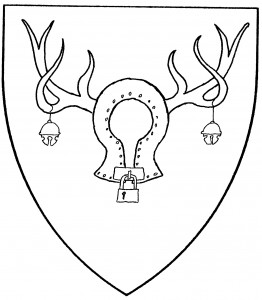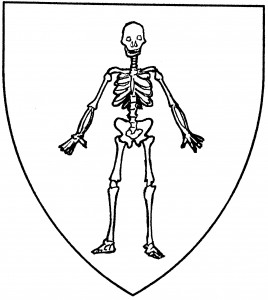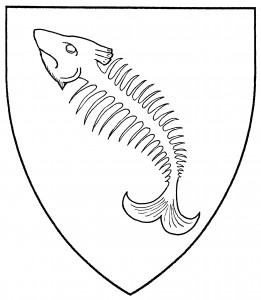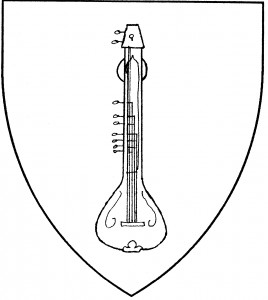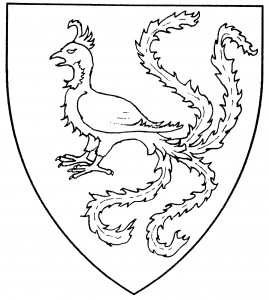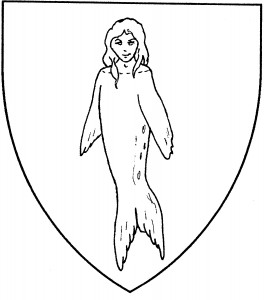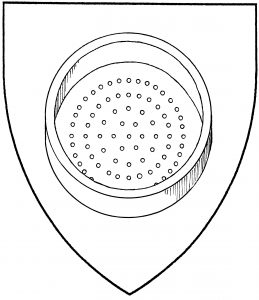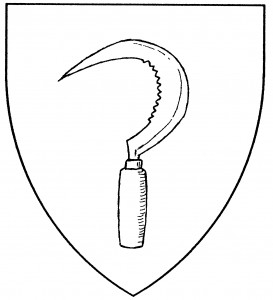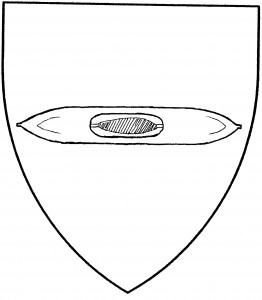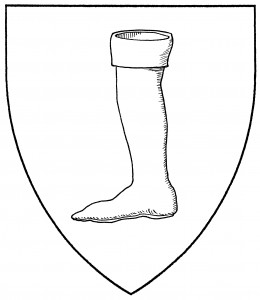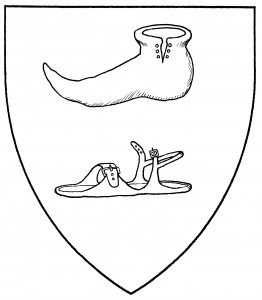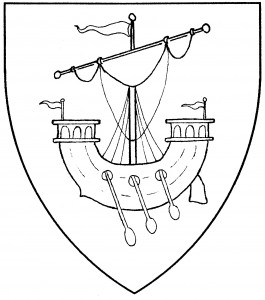
Lymphad (Period)
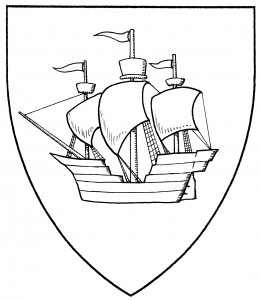
Ship, 16th C. (Period)
A ship is a sailing vessel or boat; those found in heraldry usually have sails, though there are a few oar-powered ships as well. They should be drawn as seen on a calm sea: the keel should not be depicted. All ships face to dexter by default; when “proper”, they are of brown wood.
The most common sort of ship in heraldry is the “galley” or “lymphad”: a stylized drawing, with a single square sail, and three or four oars; the sails are furled, and the oars are in action, by default. It is a period charge, found in the arms of the Earls of Katenes (Caithness) c.1310 [ANA2 548]. When the sail is unfurled, the fact must be blazoned; when the oars are shipped (i.e., inside the ship and not visible), that too is sometimes blazoned. If the lymphad has no mast, sails or oars, it may be termed a “hulk” or “hull”, as in the arms of Segger, 1605 [Siebmacher 40].
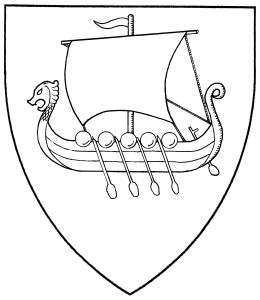
Drakkar (Accepted)
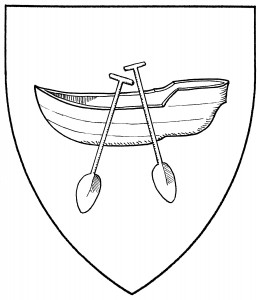
Rowboat with two oars (Period)
Later in period, ships in heraldry began to be drawn as the ships then in use: with a bowsprit, multiple masts, and square sails, as in the illustration. Such ships may be seen in the crest of Sir Francis Drake, 1581, and the arms of the East India Merchants, 1600 [Woodcock & Robinson 84, 41]. These ships were blazoned simply as “ships” or “shippes”, and increasingly, they are so blazoned in the Society as well. Society armory also has examples of more specific types of late-period ships: e.g., the “caravel”, the “carrack”, and the “galleon”. These types of ships have been drawn with triangular (lateen) sails, in addition to the square sails; they have not always been accurately depicted. But in any case, they are indistinguishable for heraldic purposes.
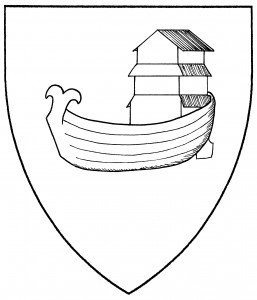
Ark (Period)
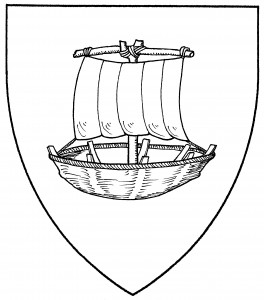
Coracle (Accepted)
In Society heraldry, the next most common ship is the “drakkar”, or Viking dragonship: with the prow carved in a monstrous head (usually a dragon’s), a square sail, and the ship’s side lined with targes. Ships decorated with dragon’s heads appear to have been used in period armory, in the arms of the Kings of Orkney, temp. Edward II [ANA2 548]. Matthew Paris, c.1245, attributes similar vessels to the arms of the King of Norway, as does Randall Holme’s Roll c.1460 [RH]; but we have no direct evidence that they were truly drakkars, or that the arms were actually in use. The drakkar is also blazoned a “Viking longship”; it’s not enough to say simply “longship”, as Norman and Phoenician longships are also found in Society armory.
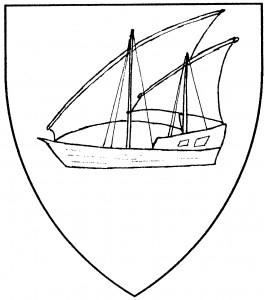
Dhow (probable SFPP)
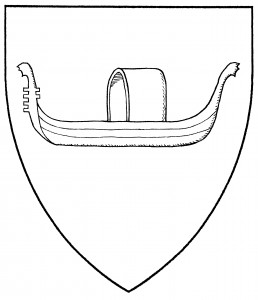
Gondola (Accepted)
The “rowboat” is a simpler craft, a shallow boat without mast, sails, or rudder, but with prominent oars surmounting it. The oars may be drawn as held in oarlocks; their number should be specified in the blazon. The rowboat is a period charge, found as early as c.1340, in the arms of Oberreiden [Zurich 284].
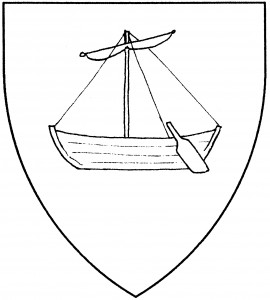
Knorr (Accepted)
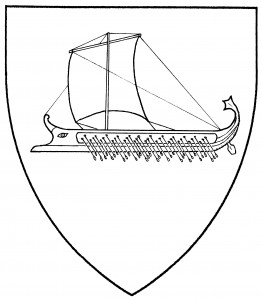
Trireme (Accepted)
Of the other, more unusual ships in Society heraldry, there is found the “ark”, a mastless vessel with a barn-like shape amidships, as seen in the crest of the Mistery of Shipwrights of England, 1606 [Bromley & Child 221]; the “coracle” or “curragh”, a small round boat made from hides stretched over a wicker frame; the “dhow”, a small Oriental ship with a triangular sail; the “gondola”, the famous traffic boat of Venice, here taken from the album amicorum (autograph book) of Gerard van Hacfort and Poppe van Feytsma, c.1570; the “knorr”, a small single-sailed boat with its rudder on the side; the “trireme”, an ancient warship named for its three rows of oars; and the “wa’a”, a Polynesian outrigger canoe with a single sail.
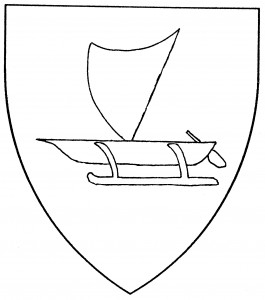
Wa’a outrigger (probable Disallowed)
The Baron of the Western Seas bears: Or, a wa’a outrigger, sail to dexter sable, within a laurel wreath vert within a bordure engrailed azure.
Lüthard von Calebergh bears: Azure, three lymphads, oars shipped, argent.
Bjornulf of Thorshafn bears: Argent, a knorr proper, sails furled vert, within a bordure azure.
Medraut Beorhtwig bears: Ermine, three drakkars in pale gules.
Royce Kensington bears: Sable, three carracks and a bordure embattled argent.
Ciaran Cluana Ferta bears: Or, a curragh proper sailed and tillered gules, in chief two Celtic crosses sable.
Burrell de Gillson bears: Azure, in chief two dolphins embowed and in base a hulk dismasted all Or.
Alexandria de Bois d’Arc bears: Purpure, an ark and a chief invected argent.
Maurice de Granada bears: Or, a dhow, sail set and sinister facing vert within a bordure vert bezanty.
Asa of the Wood bears as a badge: Azure, a gondola Or within an orle of plates.
Thomas Wright of Lancaster bears: Argent, in bend three triremes reversed azure and a chief wavy azure semy-de-lys argent.
Walborg Liucoin bears: Sable, a seven-oared rowboat, in base a bar wavy and on a chief Or three mullets sable.
